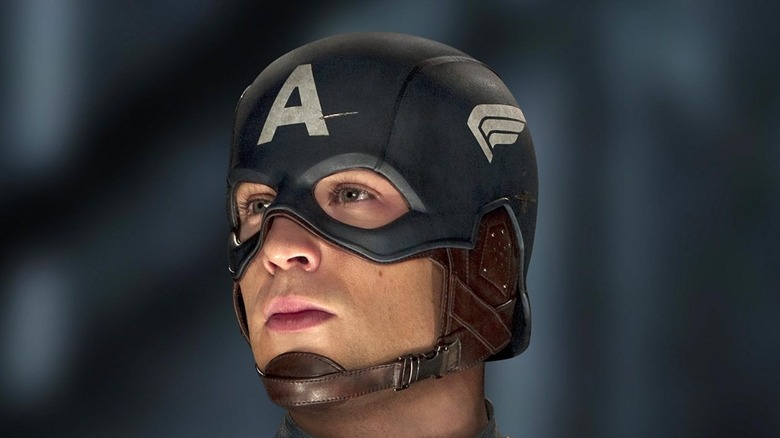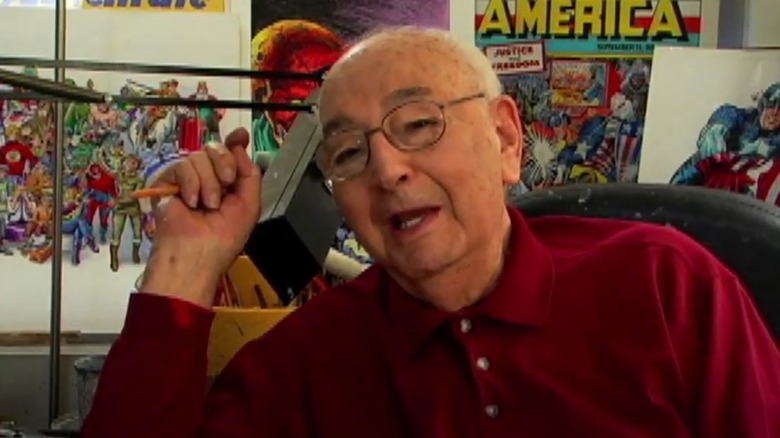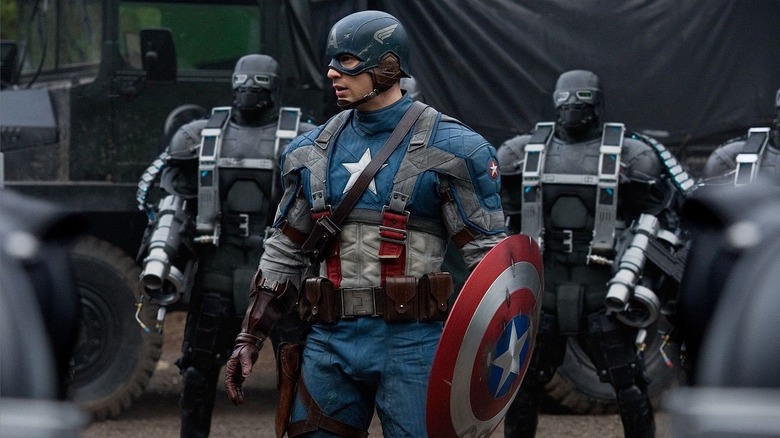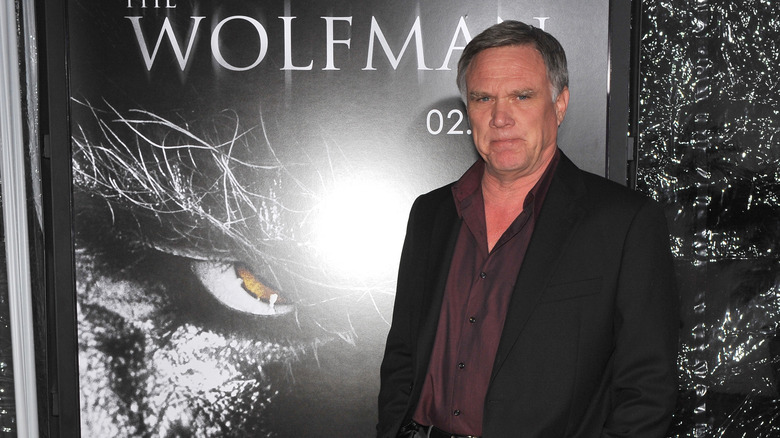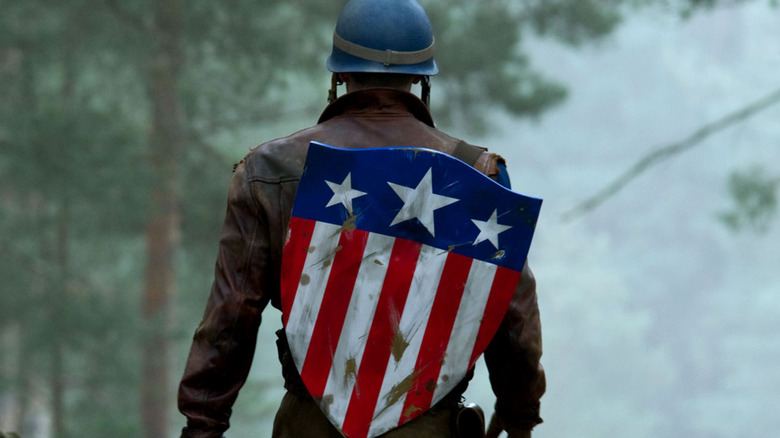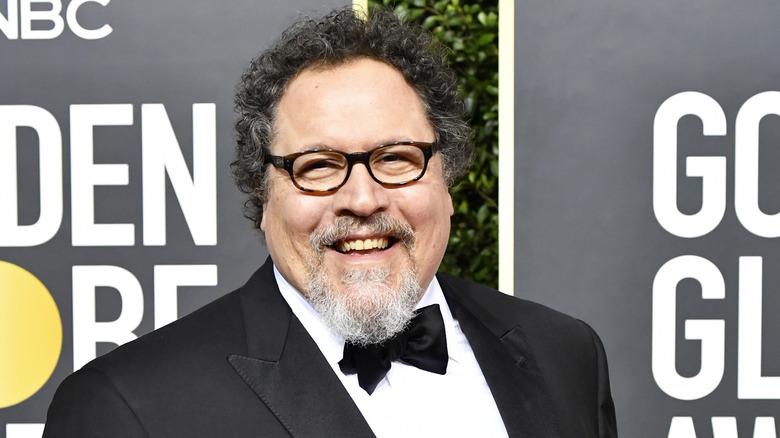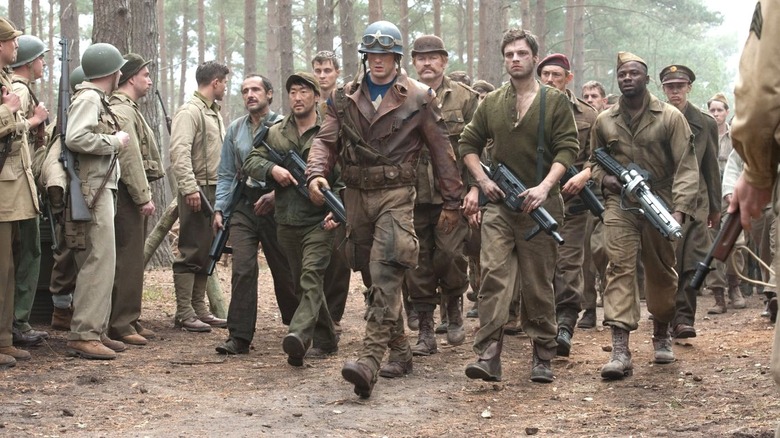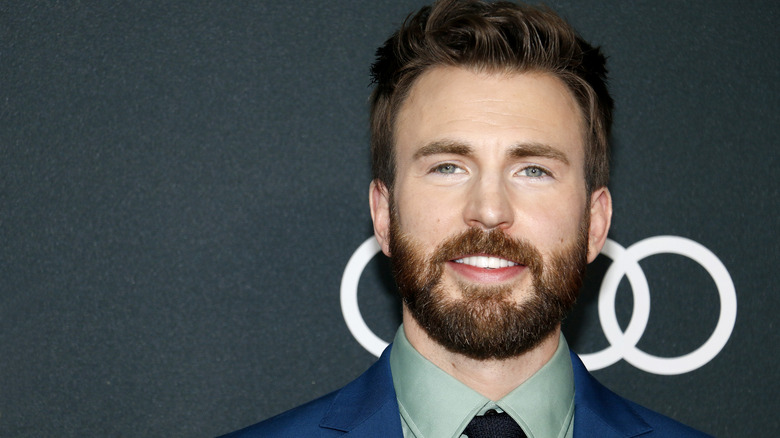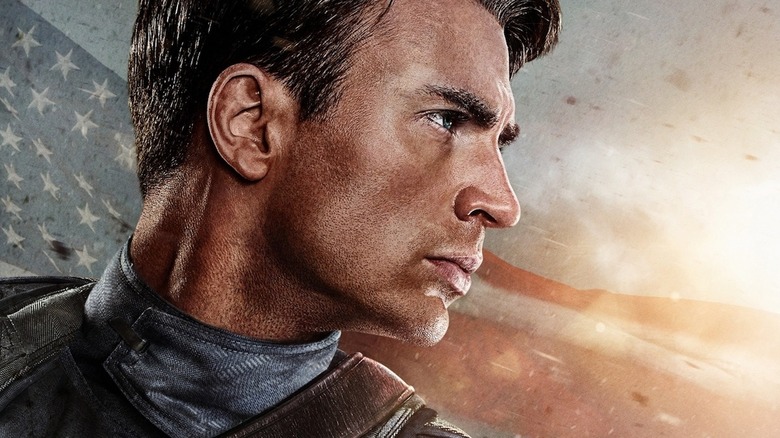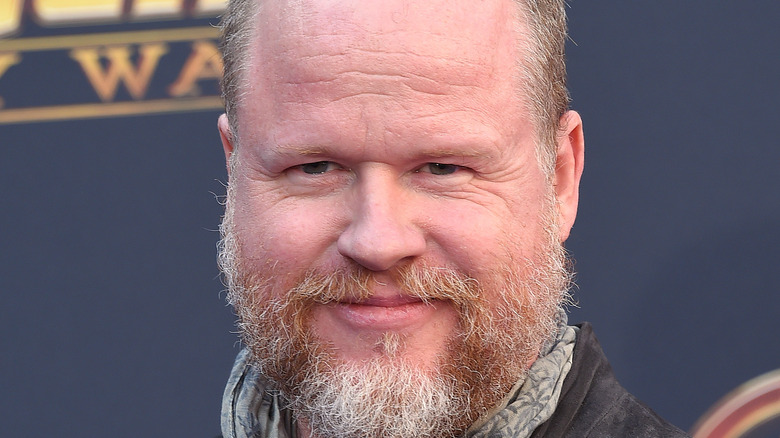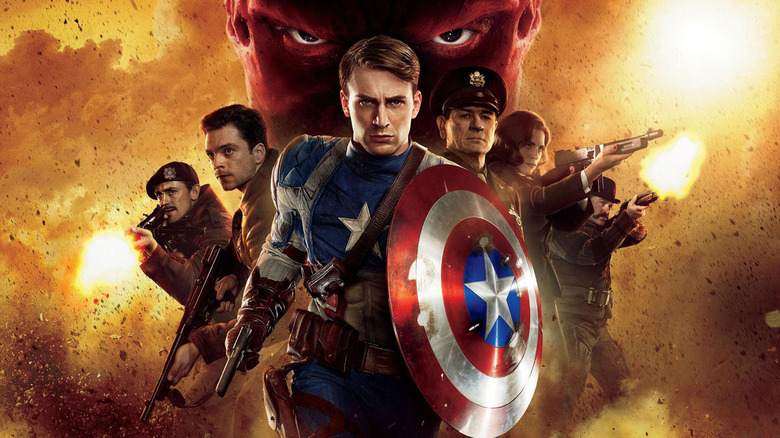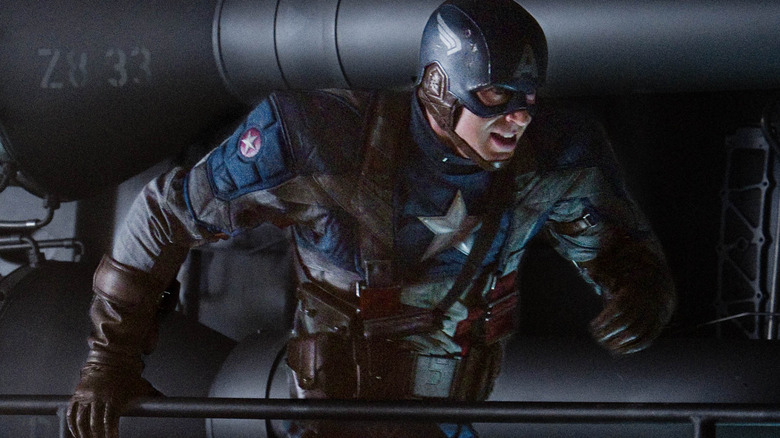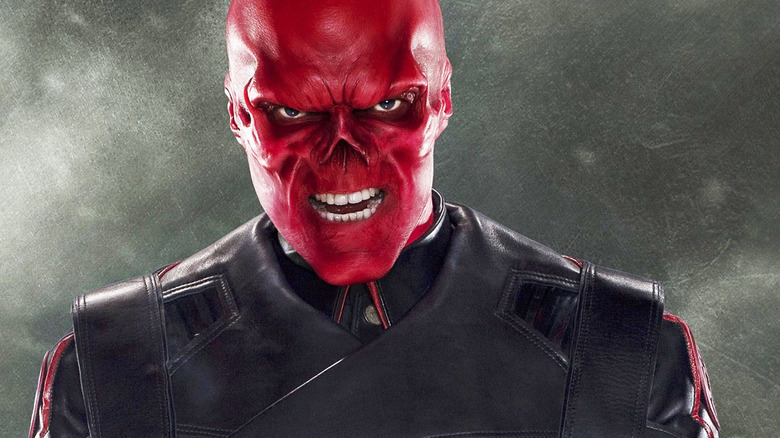The Untold Truth About Captain America: The First Avenger
"Captain America: The First Avenger" is now a decade old. It's hard to believe it's been a decade since the very first high-profile "Captain America" feature made its way to movie theater screens around the globe. Though it may not have the expansive casts of its later sequels or subsequent "Avengers" installments, this 2011 entry in the Marvel Cinematic Universe has proven to be an enduringly important part of the franchise. Not only has Captain America emerged as a pivotal figure in the series, but this film also introduced to moviegoers fan-favorite characters like Peggy Carter and Bucky Barnes. Such individuals are still being explored to this very day through Disney+ programs like "What If...?" and "The Falcon and the Winter Soldier," a testament to the lasting legacy of "The First Avenger."
It's easy to ascertain the ways "Captain America: The First Avenger" has left an impact in the years since its release. But what about all that time before it came out? The untold truth about "Captain America: The First Avenger" entails countless details about the long road this feature traveled before it arrived in movie theaters. This trek included everything from alternate storytelling approaches to difficulties casting the lead role to even a super challenging lawsuit. Though these untold truths are full of obstacles, if anyone could leap over them and deliver an enjoyable movie like "The First Avenger," it's Captain America.
The lawsuit that initially derailed a Captain America movie
Despite Captain America being one of the most well known superheroes, it took a long time for a proper big-budget movie (not starring J.D. Salinger's offspring) to get off the ground. In the 21st-century, legal problems were one of the hangups. In the final months of 2002, Publisher's Weekly revealed that Joe Simon, who created the character Captain America in the comics, was suing Marvel for ownership of the superhero.
The lawsuit was a turn of events that kept the concept of a live-action Captain America movie firmly on the shelf. However, less than a year after first being introduced, the once-daunting legal challenge dissipated. Variety reported that Marvel had settled with Simon and now planned on using its full ownership of the Star-Spangled Man with a Plan to spearhead a full-on media franchise. This was said to include movies, which, nearly a decade later, would eventually turn into "Captain America: The First Avenger."
Initial plans for setting the film in the past and present
The final version of "Captain America: The First Avenger" takes place entirely in the 1940s save for opening and closing scenes related to Steve Rogers being found frozen alive in the Arctic. However, in the film's early development process, there were plans to switch up when the project took place. Specifically, there were notions of setting the story proper in both the past and the present.
"Without giving too much away, obviously there'll be a little bit of the origin and then we come into our real world," former Marvel Studios head Avi Arad said in a 2006 interview with the Associated Press (via Superhero Hype). "What makes Captain America such a compelling character is that it allows you to judge history so you see where he came from and you see what he stood for ... One of the things our movie is going to deal with is what happened in 60 years," sayod Arad. "Which world was better? Sixty years ago or now? Within, obviously, a kick-ass plot and all the stuff that you've come to expect from a superhero movie."
Though these concepts were obviously scrapped in "The First Avenger" in favor of a retro adventure yarn, some of Arad's concepts for having Captain America confront the moral complexities of the modern world would creep into future "Captain America" movies — namely "The Winter Soldier."
Captain America (finally) gets a director
For "Captain America: The First Avenger," Marvel Studios was going to need a filmmaker well-versed in retro-style blockbuster filmmaking. That's not something that was in high supply in the late 2000s, especially with the then-modern blockbuster scene being dominated by big-budget directors obsessed with gritty realism. But Joe Johnston didn't subscribe to that notion. Getting his start doing character designs to the "Star Wars" movie, homages to classic sci-fi serials, before tackling big-budget period pieces like "The Rocketeer" and "The Wolfman," Johnston knew how to handle costly movies set in the past.
As such, it was a natural fit when Johnston was hired to helm "Captain America: The First Avenger" in November 2011, per The Hollywood Reporter. "This is a guy who designed the vehicles for 'Star Wars,' who storyboarded the convoy action sequence for 'Raiders of the Lost Ark,'" Kevin Feige said of the hiring at the time. "From 'Rocketeer' to 'October Sky' to 'The Wolfman,' you can look at pieces of his movies and see how they lead to this one." With a veteran in tackling period pieces onboard for the ride, a critical piece of the "Captain America: The First Avenger" puzzle had just been assembled.
The pivotal hiring of Christopher Marcus and Stephen McFeely
When The Hollywood Reporter broke the news in late 2008 that Christopher Marcus and Stephen McFeely had been hired to write the screenplay for "Captain America: The First Avenger," it was hard to imagine that this project would be such a long-term commitment for the pair of artists. After all, the duo had already worked on blockbusters through their work on the scripts for the first two "Narnia" movies. Penning a script for the first "Captain America" movie just seemed like another gig for these screenwriters.
However, Marcus and McFeely would end up working with "Captain America" far longer after their work on "The First Avenger" was completed than anyone could have imagined. Not only would they pen two further "Captain America" sequels, but the duo also eventually scripted "Avengers: Infinity War" and "Avengers: Endgame." They event got to work on other Marvel Cinematic Universe installments like "Thor: The Dark World." Through these screenplays, it's no exaggeration to say that Marcus and McFeely would end up being something close to critical architects of The Infinity Saga. Such a role began back in 2008 with the seemingly innocuous event of the two being hired to draft up a script for the first big-budget "Captain America" movie.
Jon Favreau once wanted to direct Captain America
Jon Favreau has become associated with various entries in the sprawling Marvel Cinematic Universe. Originally functioning primarily as the director of the first two "Iron Man" movies, he subsequently reprised his on-screen acting role as Happy Hogan in "Iron Man 3" as well as other seperate installments like the two most recent solo "Spider-Man" films. One other Marvel Cinematic Universe franchise he almost joined as well, way back in the nascent days of this media franchise, was Captain America.
While taking to Superhero Hype, Favreau mentioned his longstanding relationship with Avi Arad, a producer behind many Marvel Comics adaptations and who was initially a part of Marvel Studios. "I'd always ask [Arad] about 'Captain America,'" Favreau recounted. "This was long before Marvel broke off and became its own studio, so that was the one I was interested in, because I thought there were a lot of comedic possibilities with a guy who got frozen and then turned around and now is fighting for America." However, Favreau opted to pursue an Iron Man movie instead since he felt the character's powerset and backstory were more relevant to the technology and political climate of the world in the mid-2000s.
Picking out a name for Captain America's allies
In the final cut of "Captain America: The First Avenger," a rescue mission to save Bucky Barnes from a HYDRA prisoner camp leads to Steve Rogers encountering Dum-Dum Dugan and the other members of a unit — one that would eventually be given the moniker the Howling Commandos. This name dates all the way back to March 1964 in the lore of Marvel Comics as a team founded by Nick Fury during World War II.
Despite the teams origins sharing a backdrop as well as characters like Dum Dum Dugan with "Captain America: The First Avenger," however, the Howling Commandos weren't always going to be the name given to this group of characters. The creative team behind "The First Avenger" initially struggled to figure out a name for this collection of allies. As "The First Avenger" was hitting theaters, director Joe Johnston revealed to Newsday that the group had gone through many names during the production phase. They were once given the moniker The Invaders. In the comics, this was a superhero team that Captain America was a part of — alongside Namor and the original Human Torch — in the 1940s. Word during pre-production that the movie would feature The Invaders led to Marvel fan speculation about any other Golden Age superheroes turning up in the movie. However, it turned out just to be part of the process of giving Captain America's friends a proper name before settling on the Howling Commandos.
Selecting the actor for Captain America
The process of finding an actor who could inhabit the role of Captain America properly was perhaps the most challenging part of putting "Captain America: The First Avenger" together. "We interviewed and screen-tested probably 12 to 15 guys," director Joe Johnston told Newsday. "And we liked a lot of them. But we always came out of the meeting or the screen test saying, 'Oh, if only he were 4 inches taller, or if only his voice were a little clearer, or if he only didn't do that funny thing with his face.'" Among those who tried out were Ryan Phillipe and John Krasinski.
And then there was Chris Evans, who had previously portrayed Johnny Storm/The Human Torch in the first two "Fantastic Four" movies. The actor struck a chord with Marvel brass, but the performer initially expressed hesitance over taking on the role. "I finally got this feeling," Evans explained to Newsday, "that if I'm not doing it just because I'm afraid of it, that's no way to make a decision. I thought, 'Maybe this is exactly what I need to face, and for better or worse it'll shape who I am.' And I ended up pulling the trigger, and looking back now, thank God. Thank God. I think I'd be miserable right now seeing the trailers and the press, and really upset with myself for being a coward."
How do you make Chris Evans skinny?
For the opening scenes of "Captain America: The First Avenger," Steve Rogers would need to be portrayed a scrawny little guy, the last fellow anyone would expect to become a supersoldier like Captain America. However, there had to be consistency with Rogers across the whole film, you couldn't have different people portraying him before and after he took the serum. Looking to maintain consistency with performer Chris Evans, digital technology was used to shrink down this muscular leading man.
"We shot each skinny Steve scene at least four times," director Joe Johnston explained to Film Journal. "Once like a normal scene with Chris and his fellow actors in the scene, once with Chris alone in front of a green screen so his element could be reduced digitally, again with everyone in the scene but with Chris absent so that the shrunken Steve could be re-inserted into the scene, and finally with a body double mimicking Chris's actions in case the second technique were required." That "second technique" used to realize this original version of Rogers concerned putting the head of Evans onto a smaller performer. With these measures in place, Evans could always be playing Steve Rogers while also showcasing the drastic physical changes the character went through.
Joss Whedon revised the screenplay
In the wake of the enormous success of the first "Avengers" movie, writer/director Joss Whedon began to have a significant influence on the second phase of Marvel Cinematic Universe titles, particularly "Avengers: Age of Ultron" and scenes picked up during reshoots for "Thor: The Dark World." Before even that inaugural "Avengers" installment, though, Whedon was dipping his toes into other Marvel Studios projects thanks to him providing some rewrites on "Captain America: The First Avenger."
Of course, Whedon will be the first to admit that he wasn't overhauling the story with his screenwriting contributions. "I just got to make some character connections," Whedon explained to Earth's Mightiest. "The structure of the thing was really tight and I loved it, but there were a couple of opportunities to find his voice a little bit — and some of the other characters — and make the connections so that you understood exactly why he wanted to be who he wanted to be. And progressing through the script to flesh it out a little bit." Even if he was just making tweaks, Whedon's work on this "Captain America" title foreshadowed his future heavy screenwriting presence in the Marvel Cinematic Universe.
Converting Captain America into digital 3D
In 2010, digital 3D was all the rage thanks to the record-shattering box office success of "Avatar." All the major movie studios wanted in on this new way of experiencing cinema, particularly when it came to blockbusters. To get in on this trend as quickly as possible, studios embraced digitally converting films into the format. After releasing its first three titles with no extra bells and whistles, Marvel Studios would use this process for the first time with its 2011 films. That included "Captain America: The First Avenger."
Converting titles into digital 3D had taken on a bad rap thanks to cashgrab titles like "Clash of the Titans," but "Captain America: The First Avenger" director Joe Johnston didn't think the process had to be inherently lackluster. "I think it tends to be overused and can be a little bit gimmicky," Johnston stated to The Los Angeles Times. "A lot of people are using 3D now because they feel have they have to ... that will come and go and the pictures that deserve to be in 3D will continue to be. When it's done bad, it can make you carsick." Despite the ways bringing a film into 3D could go wrong, film industry veteran Johnston did express hope for exploring the world of 3D filmmaking. "It's a new challenge and it's exciting," Johnston said of being one of the first Marvel Studios films released in digital 3D.
The film's alternate overseas title
In the modern world, movies with the words "Captain America" in them are capable of grossing over $1.1 billion worldwide. Clearly, there isn't any concern about an overtly American character having enormous appeal to global moviegoers. Back in 2011, however, that prospect was a lot murkier, with nobody being totally sure if overseas moviegoers would come out in droves for a guy called Captain America. With Marvel Studios taking every pre-caution to ensure its individual superheroes could excel at the box office before "The Avengers" came out, this problem would have to be accounted for.
To get around this potential issue, The Guardian reported that several international territories had been offered an alternate title for the production, "The First Avenger." This moniker would convey the film's connection to the larger Marvel universe without alienating moviegoers less than thrilled about the idea of seeing a superhero dressed up in red, white, and blue. Even back then, though, the majority of overseas countries opted to keep the entire Captain America moniker, likely because the character was already well known. Only Ukraine, South Korea, and Russia decided to release the feature as "The First Avenger." All of this may seem a little silly now, but for the character's first major live-action film, extra precautions had to be taken.
Hugo Weaving's favorite part about playing Red Skull
In recent years, a cloud of negativity has sprung up over Hugo Weaving's association with the role of Red Skull. This is mostly due to Weaving being open about the challenges the actor faced from Marvel Studios in terms of getting a reasonable salary to reprise the villainous role in "Avengers: Infinity War" and "Avengers: Endgame." However, despite such recent difficulties, that doesn't mean all of Weaving's memories of playing this HYDRA leader are all bad. In fact, Weaving has openly talked in recent explained in detail his favorite part about inhabiting the nefarious role.
"I thought it would be a lot of fun to play a classic über-Nazi," Weaving said per CinemaBlend. "It was fun to play; I enjoyed the outrageousness of the German accent that I employed and I enjoyed the extraordinary mask and costume, even though it was unbelievably hot inside it. I enjoy mask work; I enjoy trying to animate masks and reveal certain things that the mask itself might not reveal." Not all of Weaving's experiences with Red Skull have been positive, but the opportunity to play someone so unabashedly wicked did offer up a lot of fun for the performer.
